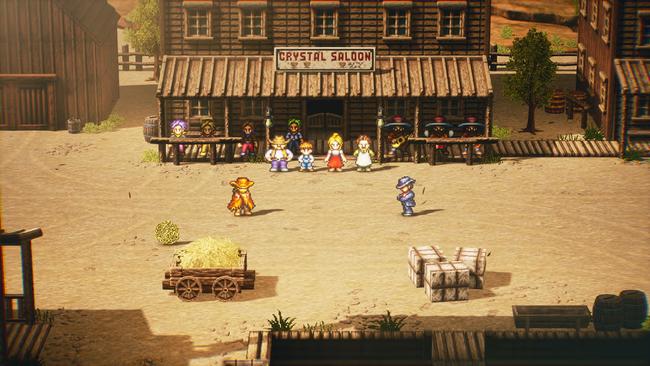
Live A Live getting a western release is a huge deal. Here’s why
Nestled into an overall pretty kick-ass Nintendo Direct was one piece of news that set a certain segment of the RPG fan base ablaze with excitement: the reveal that classic Super Famicom RPG Live A Live will finally make its way west with a HD-2D remake, published for the Switch by Nintendo.
To most, admittedly, this might not have meant much. Live A Live might be just some Japanese RPG you’ve never heard of, or have heard of, but not ever played. But like I said, a certain subset of the RPG fan base was launched into a level of excitement approaching mania by this announcement - those who have been able to play the original through a half-decent understanding of Japanese, or those willing to mess about with fan translations.
Why do these people - me included - love Live A Live so? I figured I’d write a short primer on why this game has always held a special place in my heart.
If you’re completely uninitiated to Live A Live, here’s what it is: eight SNES-era Japanese RPGs all in one. Sort of. None of these RPGs are ‘full length’, but basically the game is made up of eight unique story vignettes, all of which are separate from each other. Each story beat has its own characters, setting, and tone - all unique.
Or almost all unique, anyway. All of the stories share the same core gameplay mechanics, with things like combat and gameplay systems shared throughout them even as the characters and world changes.
Across the seven initial tales you’ll enjoy stories of cavemen in prehistory, intrigue of ninjas on secret missions, dualling cowboys teaming up against bandits, and even a robotic lifeform trying to save the lives of its flesh-and-blood masters on a space mission gone wrong, to name a few.
Each scenario is tremendously original - so, for instance, the Wild West scenario rethinks combat to be based around firearms, while the prehistory narrative features no dialogue - language not yet existing - only narrative told through animation and hieroglyphic-like symbols.
You can tackle these seven stories in any order you wish, meaning you forge a path truly your own through the game. To give each scenario a unique feel, each was led by a different artist, meaning they truly do feel like different games. Once all seven are complete, some exciting final revelations await.
Ultimately, elements from each of the stories are drawn together for a time-warping finale that brings heroes from across history together for an epic finale.

From this description, you can hopefully see the similarities to one game in particular - Chrono Trigger. Live A Live director Takashi Tokita would move straight from this project to working on Chrono Trigger, and if you’ve played both, it’s easy to see how many aspects of Live A Live, including elements of its time-hopping narrative, would go on to influence one of the greatest RPGs ever made.
If we look past the narrative, which is undoubtedly the game’s starring feature, it’s still a fascinating specimen of the time. These aren’t quite strategy RPG battles, but positioning tactics play a major role, giving Live A Live’s combat a complex edge that wasn’t present in many other RPGs of the era. A mish-mash of veterans of Final Fantasy and other Square classics descended on this game and were determined to make it stand apart. It did, and it still does.
Then, goodness, there’s the music. Composed and arranged by Yoko Shimomura of Kingdom Hearts, Final Fantasy XV, Legend of Mana, and Street Fighter II fame, this is actually the first job the legendary composer undertook as an employee at Square. In many ways, it was the perfect game for Shimomura, who had shone in composing iconic themes for different countries around the world for Street Fighter. This time, she could do the same but for different periods of time, for wildly different scenarios.
Fans of Undertale will have quietly enjoyed a piece of Live A Live’s musical legacy without even realizing it, as the iconic track ‘Megalovania’ from that game is so named as a tribute to ‘Megalomania’, one of Shimomura’s works from this game.

Shimomura’s music has perhaps been one of the most obvious showings of Live A Live’s enduring popularity with a knowing, loyal niche. Despite the original not setting sales on fire even in Japan back in the day, its fans were vocal. Shimomura’s music was frequently remixed and re-released in compilations, and there were even live concert performances as recently as 2015. The game has endured through its sheer quality and brilliance - in spite of not being the most popular game even in its era.
Probably the weakest element of the original Live A Live were its visuals. The game was originally intended to release before Final Fantasy VI, but delays meant it hit store shelves after that seminal game - and the original Live A Live looks truly dated when stood next to FF6. That was arguably the largest point against the game, the thing that even reviewers of the time slated it for - and that is now being addressed. In doing so, a great game and an important piece of Squaresoft RPG history is finally getting the release it deserves - and that's a big deal.
All this HD-2D Live A Live has to do is deliver that Octopath Traveler style visual quality onto the original game, just as it was, and people will have a new chance to experience and understand just how brilliant it is. It’s a huge piece of 16-bit RPG history - and I’m thrilled it’s finally coming West, especially in a form such as this.